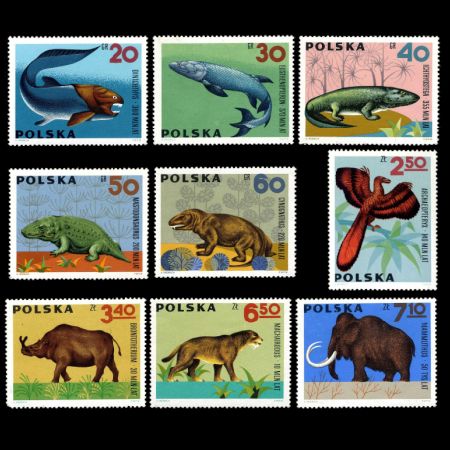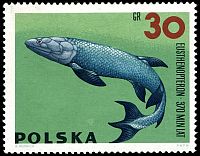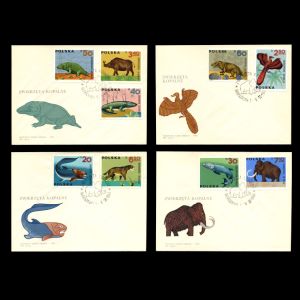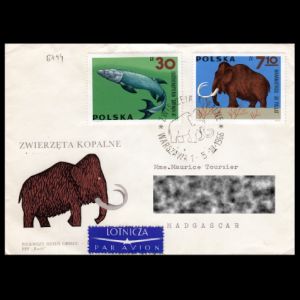Poland 1966 "Prehistoric animals"
| <prev | back to index | next> |
| Issue Date | 05.03.1966 |
| ID | Michel: 1655-1663; Scott: 1395-1403 Stanley Gibbons: 1639-1647; Yvert et Tellier: 1506-1514: Category: pR |
| Design | Andrzej Heindrich |
| Stamps in set | 9 |
| Value |
20 gr Dinichthys 30 gr Eusthenopteron 40 gr Ichthyostega 50 gr Mastodonsaurus 60 gr Cynognathus 2.50 zl Archaeopteryx 3.40 zl Broutotherium 6.50 zl Machairodus 5.60 zl Mammuthus |
| Emission/Type | commemorative |
| Places of issue | Warsaw |
| Size (width x height) | 39,5 X 51 mm / 51 x 39,5 mm |
| Layout | Sheets of 20 stamps |
| Products | FDC x 4 |
| Paper | chalky paper |
| Perforation | 12.5 x 12.5 |
| Print Technique | Offset lithography |
| Printed by | State Printing Works of Securities Warsaw (PWPW) |
| Quantity | 20 gr - 7.930.000, 30 gr - 5.136.000, 40 gr - 5.564,00, 50 gr - 3.678.200, 60 gr - 6.006.020, zl 2.50 - 2.566.020, zl 3.40 - 2.386.100,, zl 6.50 - 1.353.420 (originally 1.454.020 issued but in December 1969, 100.600 pcs destroyed by a committee), zl 7.10 - 1.068.020 (originally 1.418.020 issued but in December 1969, 350.000 pcs destroyed by a committee). |
| Issuing Authority | Poczta Polska |

On March 5th 1966, the Ministry of Posts and Telecommunication of Poland issued the set of "Prehistoric Animals".
These stamps shows major stages of vertebrate animal evolution, starting with the Devonian fish Dinichthys, through the first primitive amphibians, to the well recognized Mammoth.
This is the second Polish stamps set of prehistoric animals, the first set was issued in the previous year.
The text below is a quote from "Filatelista" magazine published in 1966, written by Dr. Andrew Sulimskiego.
In some cases translations from Polish was added, as the Polish text of the magazine has more details about some stamps.
According to the recent knowledge some statements are obsolete.
 |
| Devonian fish Dinichthys on stamp of Poland 1966 MiNr.: 1655, Scott: 1395. |
 |
| Devonian fish Eusthenopteron on stamp of Poland 1966 MiNr.: 1656, Scott: 1396. |
It was a predator and quite large: 1 meter head and trunk was about 5 meters long.
Remains of this fish are also known from and Devonian sediments of Poland.
Eusthenopteron, a representative of bony fish from the Crossopterygia group. It lived in shallow, fresh Devonian reservoirs (around 370 million years ago), and probably was the ancestor of the first primitive terrestrial amphibians.
A characteristic feature of this fish are strong, fleshy fins reinforced with bone skeleton.
 |
| Ichthyostega on stamp of Poland 1966, MiNr.: 1657, Scott: 1397. |
 |
| Mastodonsaurus on stamp of Poland 1966, MiNr.: 1658, Scott: 1398. |
This applies to the presence of scales on the body, fin rays on the tail and the structure of the skull.
Reptilian features are present in the structure of the pelvis and limbs.
The cradle of this amphibian was Greenland, back in the Upper Devonian (approx. 355 million years ago).
Mastodonsaurus, the biggest amphibian of the Triassic Period (about 200 million years ago), from the group of so-called shield-headed amphibians (Steoocephatia).
The skull is made up of thick bony plates forming the cranial armor.
On the parietal bone there was a so-called parietal eye.
The length of the skull is about 1 meter, and the body is about 2 meters.
It's probably the first reptile who leaved on land.
Remains of Mastodonsaurus found in Central Europe: Germany and Czechoslovakia.
 |
| Cynognathus on stamp of Poland 1966, MiNr.: 1659, Scott: 1399. |
 |
| Archaeopteryx on stamp of Poland 1966, MiNr.: 1660, Scott: 1400. |
The length of the body reached 2 meters. It was a predator with fur.
Its body was up to 2 meters long. Cynognathus remains are found in the Karroo formation in South Africa.
Archaeopteryx the first ancestor of birds in Upper Jurassic (about 140 million years ago).
Its remains found at lithographic limestone by Solenhofen (Bavaria - Germany).
It resembled birds in having wings and feathers, while its teeth, tail and skull showed it was still a reptile.
It was not actively flying as bird, but climbed on a tree by using a sharp claws of the forepaws (wings) and haggard figure was falling to the ground glide.
Archaeopteryx has a size more or less equal to today's pigeon and was an predator who eat some insects, worms, fruits and seeds.
 |
| Brontotherium on stamp of Poland 1966, MiNr.: 1661, Scott: 1401. |
 |
| Machairodus, on stamp of Poland 1966, MiNr.: 1662, Scott: 1402. |
It combined features of an elephant (pillar-like legs) and of a rhinoceros (body structure).
The head was equipped with forked bony outgrowths (not horny!). Brontotherium inhabited the steppes of eastern North America and Asia (Mongolia). Its remains are known from Europe too.
Machairodus, one of the most predatory representatives of cats (Felidae) in the Tertiary (approx. 10 million years ago) from the group of so-called sabre-toothed tigers.
It lived in Europe, Asia and northern Africa during the Miocene and Pliocene epochs.
Its relative from this period, Smilodon, inhabited the areas of North America. Machairodus became extinct at the beginning of the Ice Age, and its remains have also been found in Poland.
 |
| Mammuthus on stamp of Poland 1966, MiNr.: 1663, Scott: 1403. |
Mammuthus, is one of the commonest representatives of the fauna of glacial period (Pleistocene - about 100-50 thousand years ago).
Lived in the northern areas of Europe, Asia and North America.
His remains are numerous in Poland. His skeletons are on show in all major museums in the world. In Poland it can be seen at the Museum of the Polish Geological Institute in Warsaw. Its contemporary cave man hunted it and drew its pictures on the walls of the caves.
Products
| FDC (clean and circulated) | First-Day-of-Issue Postmark | |
 |
 |
 |
| Booklet | Examples of circulated covers | |
 |
 |
 |
| Production Errors | ||
 |
|
|
| Color shift | ||

|

|
References
- Technical details:
- "Filatelista" Magazine Nr 5(248), 1966 - dual language magazine: Polish/English
- colnect
Acknowledgements
- Many thanks to Katarzyna Gonet from Poland, for her help finding information about these stamps
- Many thanks to Dr. Peter Voice from Department of Geological and Environmental Sciences, Western Michigan University, for reviewing the draft page and his very valuable comments.
| <prev | back to index | next> |